GroupDocs.Classification Overview
.NET solution for automated text and document classification using various taxonomies.

Classify Text and Documents with C#
Easily classify content using IAB-2, Document, and Sentiment taxonomies with GroupDocs.Classification for .NET.
Support for Multiple File Formats
Process various document types including PDF, DOC, DOCX, RTF, TXT, and more.
Flexible Classification Options
Choose the number of results to return and adjust precision/recall balance for Documents taxonomy.
















